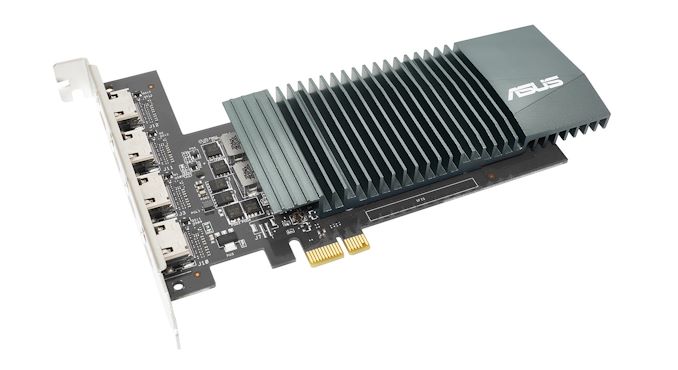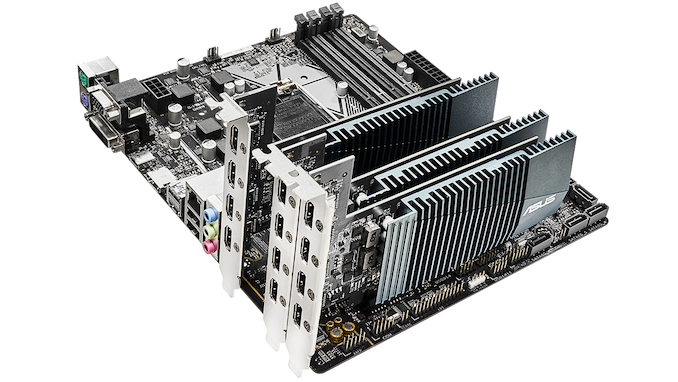ASUS Launches An Old GPU: The NVIDIA GT 710 with Four 4K HDMI Ports
by Dr. Ian Cutress on April 13, 2020 9:30 AM EST
I've noticed of late that certain companies are 'relaunching' older parts in new designs. We've seen it recently with some of the older AMD APUs finding their way into new motherboard designs, but here it's a case of a base GPU returning to the market. ASUS has listed on its website a 'new' GT 710: this is a super low end graphics chip with 192 CUDA cores on the 87 mm2 GK208 Kepler die that originally launched in late 2015 / early 2016. The goal of this sort of graphics card us to supply basic video outputs to machines that do not come with any integrated graphics on the processor.
What's different about this card, which comes with 2 GB of GDDR5 memory, is that it has four HDMI video outputs. On a modern graphics card you might expect a DisplayPort or two, but here it's all just HDMI. Despite the GK208 GPU not supporting HDMI 2.0 natively, this is the sort of card that is going to take advantage of NVIDIA opening up 4K60 with 4:2:0 subchroma sampling support on Kepler, which makes it useful for video at the most (you won't want to be running a full desktop experience with it).
ASUS states that the card can support 4K60 in this mode when one monitor is attached, or 4K30 when multiple displays are attached. Obviously with this horsepower we're not going to be doing any gaming - it's simply at the cheap end of the spectrum for office machines or library machines or similar. ASUS suggests using multiple cards at once for anyone that needs 12-16+ displays.
This card uses a PCIe 2.0 x1 connection, ensuring compatibility for a wide range of older machines, and offers a 954 MHz engine clock and a 5000 MHz memory clock. The GT710-4H-SL-2GD5 is expected to be in the ~$50 range when it comes to market.
Source: FanlessTech, ASUS


















52 Comments
View All Comments
lesp4ul - Monday, April 13, 2020 - link
Because he doesn't like nvidia. That's why he insisted.AshlayW - Monday, April 13, 2020 - link
It's cheaper. A lot cheaper. GK208 is 28nm, and GT 710 has half of the Shader Array disabled. These cards might as well come in Cereal Boxes. This is actually a fantastic idea for a system needing 8+ displays without having to splash on expensive video cards.lesp4ul - Monday, April 13, 2020 - link
Why so insisted?watzupken - Tuesday, April 14, 2020 - link
@Ian , what's wrong with MB integrated GFX, or an APU, or a different low-end GPU offering (such as RX530/RX540)?What makes this part needed?
The question is can integrated GPU support up to 12 and 16 screens? In this case, you can have 3 or 4 of these cards and run a billboard/ signage that comprises of many monitors since it just requires a PCI-E x1 slot which a MATX should offer at least 4.
I do hope Nvidia will be selling this cheap because its a very basic card.
bananaforscale - Sunday, April 19, 2020 - link
nVidia won't be selling it. It's an Asus board. And no, an integrated GPU can't support 12 screens, mostly because that's such a rare use case that there's no reason to support it. Almost everything supports 4 screens max.meacupla - Monday, April 13, 2020 - link
If stocks weren't tanking so hard, this is exactly what you'd want to run 16+ displays at once.willis936 - Monday, April 13, 2020 - link
It really isn’t. I manage a fleet of 10+ year old computers. I deal with a number of bottom of the barrel GPUs (the 710 included) trying to display anything on modern OS. If you can afford 16 monitors then you can afford a slightly better option to drive them.boozed - Monday, April 13, 2020 - link
I... how are those two things linked?eastcoast_pete - Monday, April 13, 2020 - link
Digital billboard card, 4 x HDMI 2.0 outs makes it cheaper on the monitor side (HDTVs rarely have DP connectors). Curious if this "encore" could actually play 4x 4 K video at 60p?eastcoast_pete - Monday, April 13, 2020 - link
Forgot to add: at around $ 50, it's not that much more than a PCIe card with 3 or 4 HDMI 2.0 ports to use built-in graphics, if such a thing even exists. And even a low-end Kepler isn't worse than a regular Intel iGPU.